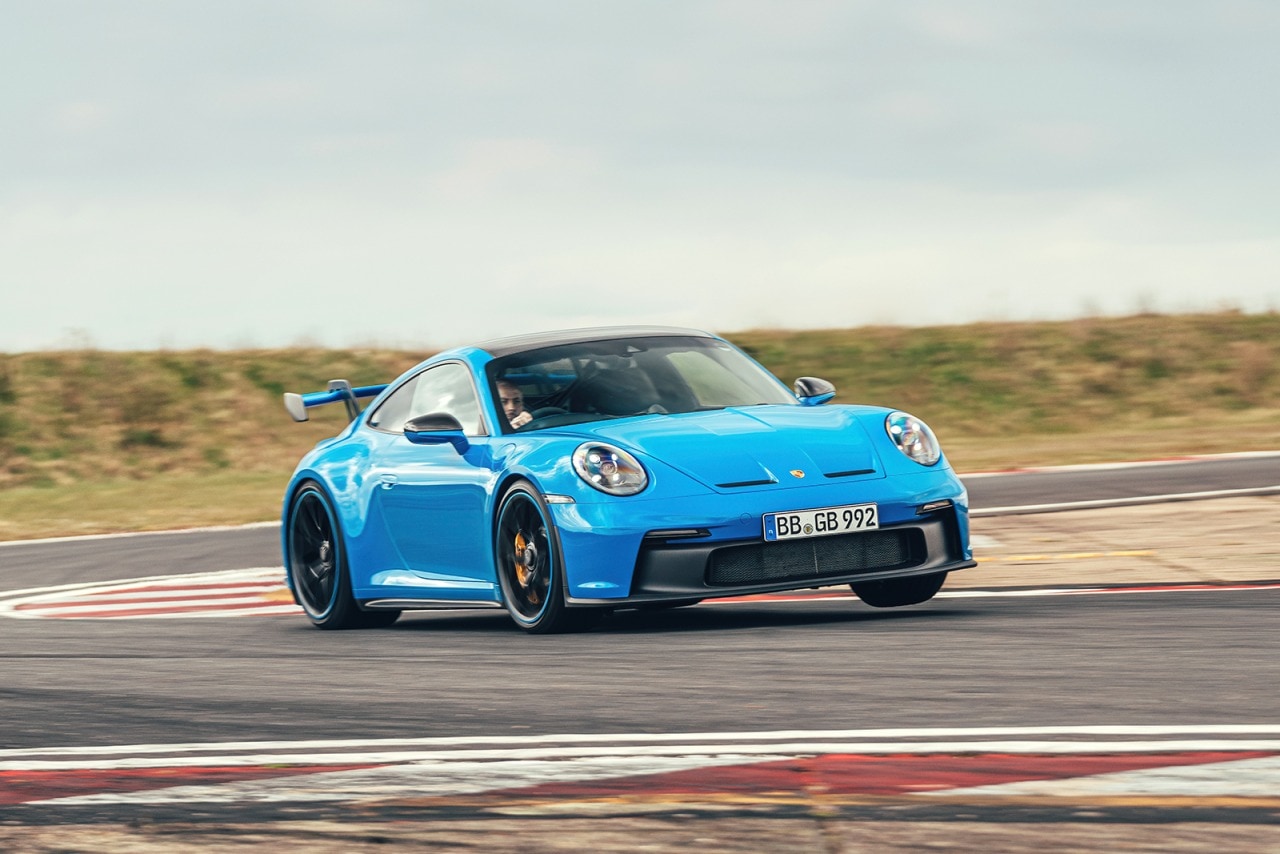- New GT3 model debuts for 2022
- Updated infotainment interface with new Android Auto integration
- Part of the eighth 911 generation introduced for 2020
What is the 911?
These days, we almost feel like our own subhead question should be: "What isn't the 911?" Every year Porsche seems to bake up new versions to fill every possible niche in the sports car market. Well, 2022 is shaping up to be no exception for this German icon. On tap is the return of the GT3 model, which we last saw for 2019. For 2022, the new GT3 is based on the eighth-generation 911 introduced for the 2020 model year.
The GT3 slots somewhere between the base-level 911 Carrera and the all-powerful 911 Turbo. Originally designed so that Porsche could take the 911 racing, the GT3 eschews a number of creature comforts and is packed with race-derived parts, all in the name of driving engagement and performance.
What's under the 911 GT3's hood?
As with the last GT3, there's a rear-mounted 4.0-liter flat-six engine powering the rear wheels. For 2022, it makes 502 horsepower and 346 lb-ft of torque. Both figures are up slightly, and Porsche lets you rev this magnificent flat-six out to a rather outrageous 9,000 rpm. Porsche says it's nearly identical to the engine used in the track-only 911 GT3 Cup.
GT3s with the dual-clutch automatic transmission (PDK) model gains Porsche Torque Vectoring Plus and an electronically controlled limited-slip differential, with the manual-equipped car featuring Porsche Torque Vectoring (without the "Plus") and a mechanical limited-slip differential. The goal of both setups is the same, however: to enhance steering response and agility when cornering.
Porsche says a PDK-equipped GT3 will rip from 0 to 60 mph in just 3.2 seconds, a hair quicker than the last 911 GT3 that Edmunds tested. Top speed is an autobahn-ready 197 mph. Choose that manual and 0-60 mph increases to 3.7 seconds, but the top speed improves marginally, to just 1 mph shy of 200 mph.
What else makes the 911 GT3 fast?
Most modern performance cars use either turbos or hybrid assist so Porsche is unusual in offering a naturally aspirated engine in the GT3, and it admits it's at the limits of what's possible with it. That's in relation to power output and its ability to meet global regulations for emissions, fuel economy and even drive-by sound. That's why the power hasn't increased since the high-revving 4.0-liter flat-six was last used in the back of the 911 Speedster. With that power effectively capped, the GT department has had to look elsewhere for performance gains and, as ever, it's looked at its race cars.
The GT3 is the first road-going 911 to feature a double-wishbone front suspension. Derived from the suspension design Porsche uses in its RSR race car, the GT3's wider front track and new front suspension design are instrumental in improving cornering stability and steering response. The rear suspension design is a multi-link setup with rear-wheel steering, but tuned to suit the GT3-specific front suspension. Porsche says no part of the GT3's suspension is shared with the standard 911 Carrera.
Creating traction are new ultra-high performance summer tires measuring 255/35R20 at the front and 315/30R20 at the rear. You can even opt for track-ready tires for the first time on a GT3. They're mounted on lighter wheels (about 3.5 pounds compared to the previous GT3's) and work in conjunction with larger front brake rotors.
The other big change is the 911 GT3's redesigned aero. There's a new front spoiler, front diffuser and rear wing, all three adjustable for better performance on a racetrack. The rear wing is particularly standout thanks to its so-called swan-neck design that attaches to the top of the wing rather than the bottom. All that wind tunnel work sees the new GT3 gain as much as 50% more downforce at speed, Porsche says, yet it achieves that without an increase in drag. Should the GT3's overly racetrack looks not be for you, a wingless GT3 Touring variant will be available sometime in the next 12 months or so.
How does the 911 GT3 drive?
Find an interesting road and the GT3 reveals just why those two letters and single digit on the rump of a 911 is such a revered and tantalizing proposition. This is a car of dual nature that really delivers the goods as you ask more of it. The suspension's control is mesmerizing, the key differentiator between this GT3 and its predecessors (and their RS relations) being that all-new front suspension.
There's a precision and accuracy to the GT3's steering that's otherworldly, yet the rest of the drive retains the hallmarks that are a 911, and specifically, a GT3, signature. There's incredible traction, huge stability, and masses of feel and engagement behind the wheel. The brakes are incredible, more so if you've optioned the PCCB (Porsche Ceramic Composite Brakes), which not only resist brake fade better than the standard, still sensational, brake rotors but also reduce the mass at the wheels significantly for even more precise control and feedback.
All that gives the GT3's glorious 4.0-liter engine a sensational platform to work with. It delivers huge performance, and a spine-tingling soundtrack as accompaniment, and the chassis is perfectly suited to exploit it all. The engine might be a high-revving screamer — peak power is delivered at a heady 8,400 rpm — but it's tractable and usable in traffic at everyday speeds. That's true of the seven-speed PDK transmission, too, it being a paragon of ease and refinement.
A real driver's car, the GT3 is rich in feel, hugely accurate and engaging to drive. It really does live up to the hype.
How comfortable is the 911 GT3?
The 911 GT3's focus is unashamedly track-biased. That overtly hardcore direction might suggest huge compromises as a daily driver, but they never really materialize. Unsurprisingly, the GT3's suspension is taut, but the chassis engineers have cleverly managed to deliver compliance rather than compromise, even on less than perfect asphalt.
The sport exhaust is switchable, so if you're wanting your GT3 a little bit more refined for a longer drive you can dial back the sound. The GT3 deliberately loses some sound deadening in its pursuit of purity and precision, so there's a bit more road noise and engine sounds than in standard Carreras or the Turbo. But it's not overtly detrimental to its usefulness as a car you'll want to drive more than just on the weekend, or around a circuit.
The driving position is excellent. Four-way adjustable sport seats are standard, and two kinds of optional seats are available — the first are 18-way adjustable seats, and the second are full carbon-fiber bucket seats. The bucket seats are the lightest and manually adjustable for fore and aft only, but they're hugely supportive and comfortable. And they are a must if you're likely to use your GT3 on track.
How's the 911 GT3's interior?
The new GT3 isn't that much different than other current 911s, save for the lack of rear seats (axed in order to save weight). That's hardly a bad thing since the new 911 has one of the most handsome and premium interiors of any sports car on sale today.
There are some GT3-specific elements around the cabin. Most notably, Porsche has swapped out the tiny PDK gear selector of the Carrera for a more traditional-looking gear selector (gear knob and all!). There's more Alcantara around the interior, too, and a GT3-specific central rev counter directly ahead of the driver, with shift lights arcing up alongside it. For a car as purposeful as the GT3, it doesn't feel like some pared-back racer inside.
How's the 911 GT3's tech?
A GT3-specific instrument cluster shows only necessary information, such as engine temperature and tire pressures in Track mode. Drive modes are simplified to just Sport and Track. These are configurable, too, allowing you to mix different drivetrain and chassis elements in an Individual mode. The GT3 loses things like the Carrera's Wet mode, and there's no automatically deploying rear spoiler either. You can alter the front and rear aero settings to different positions, but you'll need to use tools to do so.
The Sport Chrono package is again available as an option. It adds an analog stopwatch to the dashboard and allows drivers to record lap times that can be reviewed on a Porsche smartphone app. There's all the connectivity of other 911s, so you'll be able to take and make calls via your Bluetooth connected smartphone. And there's a pair of USB C ports that allow wired Android Auto smartphone integration (a new feature for the 2022 Porsche 911). Meanwhile, Apple CarPlay connects wirelessly.
Edmunds says
With every generation we question how Porsche could possibly make the GT3 any better, but that's exactly what it's done with the new 2022 911 GT3. The focus here hasn't been to up the power from the sensational 4.0-liter flat-six. Instead, the GT department concentrated on typically GT3 elements including improving the chassis, aerodynamics, braking performance and shifting weight. The results are, in short, incredible. The 911 GT3 remains the benchmark sports car for those people who love to drive.



 by
by